|
|


RECOMMENDED BY JIM PORTER
FARM 13 / STICK MARSH FISHING REPORT
OCTOBER 2002
October 28, 2002
Had three good parties out on Friday, Saturday and Sunday.
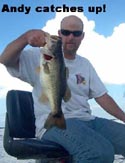 Friday, the brother team of Paul and Andy Riewe whupped up on 'em good with Traps and Texas rigs, with the worm leading the way. That was a bit remarkable, in that neither really had much experience with the worm, and Andy professing to have virtually none. After demonstrating the method and showing them that bass usually will not drop a worm unless frightened, they went to work on them. I lost count of the fish they caught, but would you believe they NEVER missed setting the hook? Not one time did either miss a set. And, only one fish came off on the jump.
Friday, the brother team of Paul and Andy Riewe whupped up on 'em good with Traps and Texas rigs, with the worm leading the way. That was a bit remarkable, in that neither really had much experience with the worm, and Andy professing to have virtually none. After demonstrating the method and showing them that bass usually will not drop a worm unless frightened, they went to work on them. I lost count of the fish they caught, but would you believe they NEVER missed setting the hook? Not one time did either miss a set. And, only one fish came off on the jump.
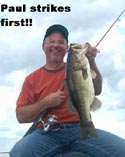 When we started, Andy indicated that he always had problems with the fish dropping his worm and with missing the hookset. He said that he always followed the advice he had gotten from some 'weekend semi-pro' about setting the hook as soon as you feel the strike. He was told to do it fast before the fish dropped the worm. We told him that was so much bull.
When we started, Andy indicated that he always had problems with the fish dropping his worm and with missing the hookset. He said that he always followed the advice he had gotten from some 'weekend semi-pro' about setting the hook as soon as you feel the strike. He was told to do it fast before the fish dropped the worm. We told him that was so much bull.
The fact is that a bass will not turn loose of a plastic worm unless he is scared or such. He apparently can't taste it, nor really tell if it is even alive. All he knows is that he has caught a prize and he WANTS it. To prove this point, I took my worm rod and made a few casts until I got a strike. I THEN LED THE BASS AROUND AND AROUND THE BOAT LIKE A DOG ON A LEASH FOR ABOUT 2 MINUTES. So long as I did not put too much pressure on the fish nor startle it, he would not drop the worm. This is something I have demonstrated hundreds of times. It is pure fact.
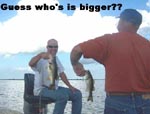 Andy wondered if the fish was so fearless because it was a real small one and just had no sense of fear yet. I set the hook and we found it to be a bit over two pounds. So much for that.
Andy wondered if the fish was so fearless because it was a real small one and just had no sense of fear yet. I set the hook and we found it to be a bit over two pounds. So much for that.
So, the lessons I gave Pail and Andy were these:
- Keep the worm moving erratically with short, quick pops of the wrist; make it dance as though trying to get away. NEVER fish a worm slowly, except in cold weather.
- When you feel the strike, DO NOT immediately set the hook.
- Wait until the fish starts to swim off. He will ALWAYS move away from the resistance he feels from the line and that means that you will be pulling the hook back towards his mouth and jaw, rather than out the front. This is important, especially if he only has the hook between his lips or outside his lips.
They did exactly as we instructed and it worked like a charm. Two more anglers saved from the doom of false information and rumor.
One of the fun things about guiding is being able to watch others catch fish and have fun. Paul and Andy were what it is all about. I think I had as much fun as they did just watching. The highlight came when they had a double, with Andy having a good fish and Paul having a dink. I wanted to take a picture, but Paul would only show his back to the camera and hold the dink under his armpit.
///////////////////////////////
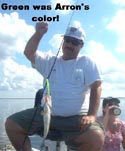 Saturday and Sunday, we hosted Arron, Brian and Becky from south Fla. Like the other recent reports said, the bass were really odd in their treatment of shiners.
Saturday and Sunday, we hosted Arron, Brian and Becky from south Fla. Like the other recent reports said, the bass were really odd in their treatment of shiners.
We started like a house of fire on Saturday morning, with bobbers flying and fish jumping. And, suddenly it ended. Just like throwing a switch. The fish seemed to toy with the baits, mouth them (if you can imagine a bass even doing that), and even blasting them out of the water. But, they would not eat them. We tried a number of other areas, but had about the same results.
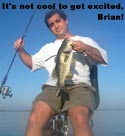 A bit later, Arron had to go in to attend to an urgent business matter. So, Brian, Becky and I went back to figure what to do. What we did was hang up the shiners and pull out the artificials. Neither Brian nor Becky had done much bass fishing, but the lessons again seemed to give them what they needed. In the next 2 hours, the two landed 16-17 fish with Becky taking one at 4 and another slightly less. Traps and the Texas rig were their tools.
A bit later, Arron had to go in to attend to an urgent business matter. So, Brian, Becky and I went back to figure what to do. What we did was hang up the shiners and pull out the artificials. Neither Brian nor Becky had done much bass fishing, but the lessons again seemed to give them what they needed. In the next 2 hours, the two landed 16-17 fish with Becky taking one at 4 and another slightly less. Traps and the Texas rig were their tools.
Sunday was another bad day for shiners. Something really odd about that. Maybe we were just in a bad place, but it sound like most everyone else must have been in a bad place, too. Talking to some other guides when we got in indicated even artificials did not do well. Well, Arron, Becky and Brian probably had what you would call a good day, but not anything to write home about. We gave the shiners an hour on three normally excellent places and then shut their door again. Back to the Trap and that worm.
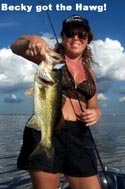 This time Arron got into the act. Everyone caught fish. And, even the guide caught a couple at the request of the clients. Brian and I teamed up against Arron and Becky (who are husband and wife) for a series of 20-minute competition periods. Usually, 4 fish by a team in 20 minutes would win, with the other team only 1-2 fish behind. It made for a fun day.
This time Arron got into the act. Everyone caught fish. And, even the guide caught a couple at the request of the clients. Brian and I teamed up against Arron and Becky (who are husband and wife) for a series of 20-minute competition periods. Usually, 4 fish by a team in 20 minutes would win, with the other team only 1-2 fish behind. It made for a fun day.
The road is in good shape, the water levels are normal and the water condition is excellent. There is a lot of grass in the north-center portion of the farm side and it is holding a lot of floaters wedged in place. Pay attention and watch for them. Also, watch for the fish to start to move more to the south end of the Farm, to the wooded areas, as the weather finally cools down in Fla. That will start the latter part of this week.
October 18, 2002
Fishing continues really good. You just have to put up with hordes of small fish in-between the decent fish bites. There are just SO MANY small bass - but, that is something to be so thankful for! The huge baitfish pods are also a blessing.
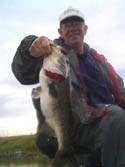 We went out the other day with our old friend, Art Norris (see photo from last year). Art's son, Ron, gets too much of the Michigan cold a couple of times a year and comes south to fish with us. Art has now moved here permanently (as in 'retired') and is much closer to the fishing hole than Ron. Art tells us that Ron has been fishing the Pro-Am smallmouth tournaments around and on the Great Lakes and doing rather well. In his first year, he placed 50th overall. That got him enough prize money to recoup all his entry fees. Good show, Ron!!
We went out the other day with our old friend, Art Norris (see photo from last year). Art's son, Ron, gets too much of the Michigan cold a couple of times a year and comes south to fish with us. Art has now moved here permanently (as in 'retired') and is much closer to the fishing hole than Ron. Art tells us that Ron has been fishing the Pro-Am smallmouth tournaments around and on the Great Lakes and doing rather well. In his first year, he placed 50th overall. That got him enough prize money to recoup all his entry fees. Good show, Ron!!
Art and I went to the Farm side for an afternoon of 'catching'. With the fish so thick and after baitfish so strongly, we can safely say 'catching' rather than 'fishing'. We KNEW we would do well. And, 'well' we did. The small fish ate us up, but we never did get anything big. As art said, 'It sure beats unpacking boxes" (he is still in the post-moving position with a house full of cardboard stacked everywhere). My position was that I just want a tug on the line. The strike is where it's at. After that, it's all work (pulling the fish in, getting the hooks out, wiping my hands, fixing the lure, casting again). I did not count the fish, but it was certainly very high, if not any size.
Yesterday, my afternoon client called in to cancel, so I went anyway. Randy Sanders (Fish On Bass Fishing Excursions) had mentioned something to me at the ramp about some places he had been doing well. One was a place that I told him was very near a big fish school location. It was very difficult to find unless the grass was on the surface well, I told him, and I had not been able to get on it. This made me think about the spot, so I gave it a shot.
Guess what? I found that puppy!! I probably can't do it again, because it cannot be visually located without the grass. I just worked around until I happened to catch a 4-lb fish and tossed out a marker. Turns out the fish must have come off the spot, because there were 5 more there between 4 and 7 lbs. (just like I told Randy the sizes and quantities ran). I don't know what is there that holds those good fish all the time. It seems like any other hard bottom area along a canal levee. Must be a cold water spring or something, though. It has been a super place for the last 6 years. The only problem is that, if I fish it every day, it will usually be good only every other day or every 3rd day. If I let it alone, it works most times. I am careful not to show this to any local people, only out-of-town customers. And, that is only when I can find it. I tried the GPS, but it does not seem to get me there. Anyway, it says the small bass haven't completely taken over all the places.
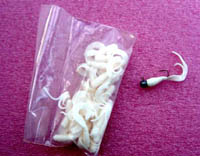 Moving back to where Art and I fished the day before, I found no breaking fish at all. BUT, the bass were still there. Only, this time, they were a half-pound to a pound better than the day before. And, the crappie seemed mixed in with them. They would take most any lure fairly well. But, when I caught a big slab crappie, I switched to a white twister-tail grub (BPS Triple-Ripple to be exact) on a 1/8th oz head (see the photo; this is about as simple as fishing gets).The grub did not always make it to the bottom. Too many small bass still around. But, if I could get it down in the deep water of the canal I was fishing along, all I had to do was hop it off the bottom sharply and let it fall back and bang - it was bigger fish time. You might want to remember this lure and technique. It is something that is very popular is some location when the bass are surface feeding on small baitfish (like they are now). Get the jig down BELOW the baitfish and small bass, and the larger ones will be there waiting for the crippled shad to drop down to the bottom.
Moving back to where Art and I fished the day before, I found no breaking fish at all. BUT, the bass were still there. Only, this time, they were a half-pound to a pound better than the day before. And, the crappie seemed mixed in with them. They would take most any lure fairly well. But, when I caught a big slab crappie, I switched to a white twister-tail grub (BPS Triple-Ripple to be exact) on a 1/8th oz head (see the photo; this is about as simple as fishing gets).The grub did not always make it to the bottom. Too many small bass still around. But, if I could get it down in the deep water of the canal I was fishing along, all I had to do was hop it off the bottom sharply and let it fall back and bang - it was bigger fish time. You might want to remember this lure and technique. It is something that is very popular is some location when the bass are surface feeding on small baitfish (like they are now). Get the jig down BELOW the baitfish and small bass, and the larger ones will be there waiting for the crippled shad to drop down to the bottom.
The great Skeeter Hawk boat restoration project is underway. Take a look and follow the progress at www.jimporter.org/skeeter/part1.shtml.
October 10, 2002
Our fine Stick Marsh bass and crappie continue to cooperate extremely well. We are seeing such tremendous numbers of smaller schooling bass that it really make the future of the Marsh appear well secure.
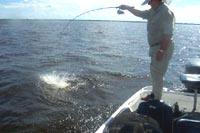 Fish populations appear to follow some pattern of variation over a given period of years. Possibly, it is caused by good and bad spawning years, water quality effects on young-of-the-year survival rates, or maybe just Mother Nature controlling the population to fit the habitat and food supplies. Whatever it may be, we appear to have experienced a reduction in small bass populations the past 2-3 years. Even though the larger bass and the density of trophy fish appeared to remain the same, small bass up to 14 inches appeared to have diminished. But, from what we are seeing now, the next 4-5 years look excellent.
Fish populations appear to follow some pattern of variation over a given period of years. Possibly, it is caused by good and bad spawning years, water quality effects on young-of-the-year survival rates, or maybe just Mother Nature controlling the population to fit the habitat and food supplies. Whatever it may be, we appear to have experienced a reduction in small bass populations the past 2-3 years. Even though the larger bass and the density of trophy fish appeared to remain the same, small bass up to 14 inches appeared to have diminished. But, from what we are seeing now, the next 4-5 years look excellent.
Crappie have always been a high-density fish in the Marsh. In the earlier years, before the major grass growth set in, crappie were so easy to catch that it was probably the best in the World. A three-pound crappie was a daily occurrence, and some closing on four pounds were caught occasionally. With little grass available, the crappie all concentrated themselves in the deeper canal channels and were easy pickings.
Today, however, there is so much grass in the impoundment that the crappie can be just about anywhere and everywhere. Dense concentrations are more difficult to locate and the grass makes it harder to get to the fish effectively. However, the crappie populations are still about the same, if not larger. The dedicated crappie angler, who applies himself/herself, will find plenty of fish. And, as previously stated, they are just about everywhere. If there is grass, there will be crappie in the vicinity.
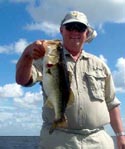 Last week, we had Ken Knapp fish with us again. Ken, his son Tracy, and Jay Forman (now the starting inside left linebacker for Houston) started fishing with us a few years back and have always had successful trips. (I sometimes wonder if it is my luck as a guide or if they are just lucky anglers. Whatever, I wish fishing was always as good as it is when I get to team up with that group.) Taking Ken to an area where the schooling bass were hanging out, he immediately proceeded to take up where he had left off last year. Tossing a Trap down a canal channel, he was fast to a 4-pound fish as soon as it hit the water. I am not sure how many we caught in that location, but it was a sizeable number. Only a dozen exceeded 2 pounds, but there were hoards of smaller ones ready and willing to eat worms and plugs. Ken also got an introduction to the JUNIOR (4-inch version) Swimming Worm and found schooling bass ate it on nearly every cast.
Last week, we had Ken Knapp fish with us again. Ken, his son Tracy, and Jay Forman (now the starting inside left linebacker for Houston) started fishing with us a few years back and have always had successful trips. (I sometimes wonder if it is my luck as a guide or if they are just lucky anglers. Whatever, I wish fishing was always as good as it is when I get to team up with that group.) Taking Ken to an area where the schooling bass were hanging out, he immediately proceeded to take up where he had left off last year. Tossing a Trap down a canal channel, he was fast to a 4-pound fish as soon as it hit the water. I am not sure how many we caught in that location, but it was a sizeable number. Only a dozen exceeded 2 pounds, but there were hoards of smaller ones ready and willing to eat worms and plugs. Ken also got an introduction to the JUNIOR (4-inch version) Swimming Worm and found schooling bass ate it on nearly every cast.
Next, we had Sunny Wells out for an afternoon. The story was about the same as with Ken Knapp, in that the bass were readily available and easy to catch. The surface schooling action was not as strong, but the fish were still present and not shy of the lures. After tiring of catching the bass, we decided to test the crappie populations.
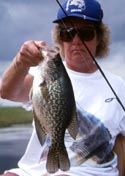 Working around a few grass beds with jigs, we found small crappie in large numbers. The best way to locate them was to vertical jig right up against the grass and hyacinths (best done with a jig whose balance point allows it to position horizontally, such as our PERFECT jig) and to drop the jig into any hole back in the cover. As is usually the case, fishing the jig a few inches off the bottom was the best approach. A few minutes before sundown, Sunny caught a couple of big crappie off a submerged grass bed by bringing the jig across the top of it. Working that location further, we noted the fish to be much larger, on the average. The next afternoon, my wife and I checked the location again and found it held a great number of large crappie. I am not sure why the crappie are so active at this particular time. Usually, that does not start until we have the beginning of the Fall cool-down. But, they are eating the jigs like there will be no tomorrow and I am not going to complain.
Working around a few grass beds with jigs, we found small crappie in large numbers. The best way to locate them was to vertical jig right up against the grass and hyacinths (best done with a jig whose balance point allows it to position horizontally, such as our PERFECT jig) and to drop the jig into any hole back in the cover. As is usually the case, fishing the jig a few inches off the bottom was the best approach. A few minutes before sundown, Sunny caught a couple of big crappie off a submerged grass bed by bringing the jig across the top of it. Working that location further, we noted the fish to be much larger, on the average. The next afternoon, my wife and I checked the location again and found it held a great number of large crappie. I am not sure why the crappie are so active at this particular time. Usually, that does not start until we have the beginning of the Fall cool-down. But, they are eating the jigs like there will be no tomorrow and I am not going to complain.
The ramp area continues to be used very little and few anglers are visiting the Stick Marsh right now. That's a shame with such good fishing going on. So, if you get the chance, you might want to give it a try before the tourist season starts and things get crowded.
October 1, 2002
Just a bit of amplification on the last report I posted a few days ago -- We have been back to the Marsh 3 more times, again from around 4-7PM. The wife was with me two trips and Lou was there yesterday.
Guys and gals, you can catch ALL the bass you want, IF size is not the object. And, if you work around the area in which you find the small schooling bass, you will eventually find some solid 2-3 lbers.
Each day, we basically anchored the boat and never moved after we located a big school. (They are easy to find, if the wind does not obscure their surface activity too much.) I sat and watched Dot hook 26 on 26 casts using a worm. Yesterday, Lou and I both caught a fish a cast for 45 minutes straight, with 7 instances of 2 on one lure (Rat-L-Traps). That says those bass were really thick in there. To make it even better, there were some good 2-3 LB bass mixed in. We had 8-10 of those mixed into the catch, but I think all the small bass just beat the larger ones to the lure most times. It was an opening between two grass lines, one of which was on the levee of the Farms east/west canal. There are small ditches that run on the outside of the levees and that is the open water they were using.
The winds have been pretty strong, but we put two anchors down together off one cleat and it managed to hold once the anchors dragged up to the levee edge. Get the fishing while it's hot!! It won't stay this way forever. And, remember to move around to locate the larger fish once you find the small ones.
September 27, 2002
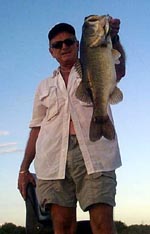 Here we are back in Florida after a summer of chasing smallmouths in the North Carolina mountains. Quite a change, too. Daytime temps in the Stick Marsh are 90-93, with high humidity and plenty of rain. Here we are back in Florida after a summer of chasing smallmouths in the North Carolina mountains. Quite a change, too. Daytime temps in the Stick Marsh are 90-93, with high humidity and plenty of rain.
Today, we made our first return to the Marsh and what a welcome back it was! Nothing has changed and the fish are doing exactly what they have always done at this time of year.
Arriving at the ramp at 3 PM, we found two vehicles - both turned out to be crappie fishermen. There was no rain in sight and none happened by. So, after I got back to the ramp, I wondered why so many anglers are passing up the present great fishing (?). Maybe I just hit it right and the fishing has been poor up to now. I don't know that answer. But, here is what I found yesterday.
The first stop was at the opening in the trees near the ramp. No current was present. The Swimming Worm picked three fish off the edges of the drop on the sump hole. That is about par for any fishing day at that location.
Next, we tried the old submerged roadbed we like. Zilch on that place.
The end of the levee separating the Marsh and the Farm was our next target. Nothing came to the Rat-L-Trap. But, the Carolina Rig managed to get 5 small dinks and one about 3 lbs.
The East gate of the Farm was not running, but we got one nice fish off the back lip of the blowout hole on a crank plug.
Moving down the east-west canal running from that gate to the shack on the west bank, we tried a canal intersection. Nothing came on worms or cranks. But, just as we were about to move again, we spotted a huge school busting baitfish off to the west.
The schooling location was like running into an old friend again. Bass have used this 100-meter square area for decimating baitfish schools ever since the Marsh/Farm complex was new. From somewhere around late summer through the first cool days of November, this pattern is very predictable.
But, you just have to watch for the signs, in that you may not actually see the bass churning on the surface as you pass by. It is an odd thing, but the bass and the larger needlefish seems to run together when surface feeding. It may not actually be that congenial a relationship and may actually be one breed or the other simply 'butting in' on the other party. It is difficult to tell. Sometimes, the bass break on the baitfish first, followed by flying needlefish. At other times, only the needlefish will be seen running the baitfish and flipping through the air. BUT, that is usually a giveaway that bass are also active in the same area. It is also a sign that most of the bass will probably be small, in that the baitfish will be small. Needlefish do not seem to surface feed on anything but 1-1/2 inch, and smaller, baitfish. Occasionally, while catching the smaller bass, an old good 'un will blast your stuff. But, that is a bonus.
If the schooling bass are generally above two lbs., the baitfish will be large and the needlefish will not appear to be present. Then, you must watch for baitfish activity rather than needlefish. Dimples, small breaks and splashes on the surface usually mean gar rolling at flipping their tails, or small fish feeding on tiny insects. Disregard that activity. When actively feeding bass are in an area, you will see baitfish jump horizontally across the surface in a mad dash to save their tails from something with a big mouth. Unless the activity seen looks like a panic getaway effort, it probably means nothing.
We got over to the schooling activity after the school had sounded. But, there were needlefish flipping and chasing all over the open area. So, we tried a ¼ oz Rat-L-Trap. That worked great. We tried two types of small topwater plugs and they got eaten regularly, especially if we got to a break location quickly. No matter if it was a needlefish chasing the minnow, there would also be a bass there, too. What really worked best, if I do say so myself, was my small 4-inch Swimming Worm, the Junior. It would get a bass on nearly every cast.
The sad part is that these fish ran an average of only 1-1/2 lbs., with a couple of 2-1/2 lbers. That just happened by to see what was happening. It was fun, but I finally left it to work one final location.
I LIKE the SW corner of the Farm! It has always been my very favorite place in the impoundment. While I have caught most of my giant bass in other locations, that SW corner has lots of fish, a diversity of cover, and is just FUN to fish. I particularly like to take the Swimming Worm and work down the south end of that far west canal (running from just below the shack to its southern end). It is a very predictable Swimming Worm location, as many of my past guide parties can attest to. So, I was not surprised when I found a lot of fish along the west side of the canal. Most were in the 2 to 2-1/2 lb. range, with one good old 5 lb. girl that tore a new worm all to heck.
So, we are back and the Stick Marsh is still kicking and bristling with fish. I am still wondering, though, why no one is out there. Afternoons are great when the storms are absent.
If you are in the area and we can dodge the storms, ½ day trips in the afternoons (2:30 PM until dark) are going for $150. An extra person can come at no additional charge.

Today's Weather for
the Stick Marsh Area
Past Fishing Reports
Farm 13/Stick Marsh Information Guide
Email questions to jporter@jimporter.org.
|
Recommended sites by The Fishin' Tipster |
A common question that we get: "Is there somewhere close to get bait and tackle?" This is where we get our bait.

Pete and Tina Heinz / 9 South Mulberry St. / Fellsmere, FL 32948 / 772-571-9855
Get your site listed here
Let us help you drive more targeted traffic to your site.
|


Rank our Site
©Copyright 2001-07 All rights reserved by Jim Porter, any reproduction, quotation or other use of this site or its elements is prohibited without the express written permission of Jim Porter
|
|


 FROGG TOGGS RAIN GEAR
FROGG TOGGS RAIN GEAR
THE BEST PRICES AVAILABLE!!


|
|







